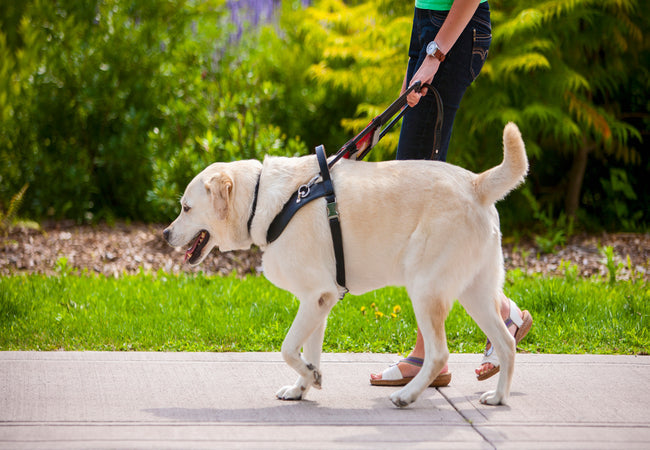How No‑Pull Dog Harnesses Work in 2025 – Vet‑Approved Guide 🐶🛡️

In this article
How No‑Pull Dog Harnesses Work in 2025 – Vet‑Approved Guide 🐶🛡️
By Dr. Duncan Houston BVSc
Struggling with a dog that pulls you down the street? No‑pull harnesses (aka front‑clip harnesses) are a game‑changer—they work with your pup’s instincts to reduce strain and teach better leash manners. In this 2025 vet-verified guide, I’ll break down how they function, what to look for, training tricks, and when to pair them with professional help.
🧠 Why Regular Collars Are a Problem
Traditional collars put pressure directly on the throat and trachea, causing neck injuries, coughing, and even behavioral associations between walking and discomfort. Small breeds are especially vulnerable to throatl damage.
🔧 How No‑Pull Harnesses Work
1. Front‑Clip Redirection
No‑pull harnesses have a leash attachment on the chest. When a dog pulls, the leash angle shifts, pivoting the dog sideways and steering them toward you rather than forward.
2. Gentle Pressure Training
They use light pressure as negative reinforcement—when the dog eases up, the pressure releases. Over time, dogs learn that pulling makes walking harder.
3. Interfering with Momentum
By removing forward thrust, the harness breaks the dog's pulling effort. Resistance teaches them that staying close equals freedom.
4. Full‑Body Distribution
Pressure spreads across the shoulders and chest, avoiding neck injuries or tracheal strain common in collars.
🧩 Biomechanics & Behavioral Basis
- Operant conditioning: Pulling reduces progress—dogs learn looser leash = forward motion.
- Redirection mechanics: Physical design turns pulling into steering, allowing easier control.
- Reduced stress: Studies show calmer dogs using front‑clip harnesses versus collars.
🔎 Choosing the Right Harness
Front Clip vs Dual‑Clip
Front‑clip is ideal for pullers. Dual‑clip (front + back, e.g., Blue‑9 Balance) gives control versatility—start front, switch to back as training progresses.
Fit & Sizing
Measure chest girth behind the front legs. Ensure two‑finger fit—not too loose or tight. Padding and wide straps reduce chafing.
Materials & Durability
Look for sturdy, breathable materials. Mesh or neoprene is good for comfort and long walks.
Recommended Brands
- **PetSafe Easy Walk** – front-clip classic, padded, reflective. Praised by People as a “game‑changer”.
- **2 Hounds Freedom / Blue-9 Balance** – dual‑clip, adjustable, trainer favorite.
- **Frisco padded front‑lead** – good value, comfy padding.
🏋️♂️ Introducing the Harness – Training Tips
- Let your dog sniff and explore it off‑leash.
- Practice buckling while rewarding with treats.
- Start with short indoor sessions, rewarding calm behavior.
- Begin leashed walks: reward slack leash, stop walking if pulling starts.
- Gradually increase duration, always reinforcing loose leash.
- Phase out treats eventually, replacing with praise or a toy.
⚠️ Limitations & Considerations
- Training required: Harness aids, but doesn’t replace loose leash training.
- Movement restriction risk: Poor fit could hinder gait or cause muscle strain.
- Misuse risk: Avoid punitive use—no yanking or sudden jerks.
- Not for all: Severe reactive dogs may need additional behavior support.
🚶♀️ Harness‑Based Walk Training Plan
| Step | Goal | Tools |
|---|---|---|
| Start indoors | Get comfortable with harness | Treats, praise |
| Short walks | Loose leash awareness | Front‑clip harness, treats |
| Add distractions | Maintain leash relaxation | Dual‑clip, obedience cues |
| Reinforce & Fade treats | Walk politely w/o food | Verbal praise |
| Manage real world | React calmly | Harness + training timeout |
📱 Ask A Vet 2025 Integration
Confused about fit or training? With the Ask A Vet app you can:
- Share photos/videos of harness fit and leash behavior
- Get customized treat plans and reinforcement schedules
- Coordinate with trainers via vet referrals
- Track progress and troubleshoot issues anytime
We're here to help you achieve calm, confident walks! 🐾📲
✅ Final Thoughts
No‑pull harnesses offer a science-backed, humane alternative to choke or prong collars—by steering pulling toward steering, distributing pressure, and teaching better habits through operant learning. But success depends on proper fit, patient training, and sometimes professional guidance. In 2025, this approach makes walks safer, happier, and healthier—for you and your dog. 😊
Need tailored advice? Visit AskAVet.com or download the Ask A Vet app for real‑time vet and trainer support on harness fit, behavior plans, and walk improvement.






